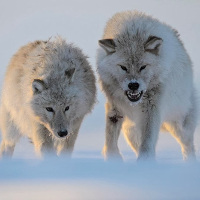 |
Tundra wolf |
|
He is a wild animal |
Origin |
Russia | |
Translation |
Francis Vandersteen |
| The possession of this animal is not authorized Royal Decree establishing the list of mammals not kept for production purposes that may be kept (M.B. 24.08.2009) |
| The tundra wolf Canis lupus albus is one of the largest subspecies of the gray wolf. It was classified as a subspecies by Robert Kerr in 1792. Tundra wolves live mainly in the northern and boreal arctic regions of Russia, between 65 and 71 degrees latitude. Tundra wolves can measure up to 2.15 m in length from nose to tail. There have been unconfirmed reports of some weighing up to 100 kg. However, on average, Tundra wolves weigh between 45 and 57 kg. Their height can range from 71 to 97 cm. Most have coats that are a combination of gray, black, rust and silver-gray. They are known to have long, thick coats with dense undercoats, and are often hunted for them. Average lifespan is around 16 years. They feed mainly on large mammals such as deer, elk, moose, caribou, bison, muskox and mountain sheep. Because the capture of large animals is not a daily occurrence, an adult tundra wolf can eat up to 9 kg in a single sitting. Contrary to the belief that wolves primarily target crippled creatures, wolf research in Eurasia has shown that in some cases, up to 93% of their targeted prey have no physical or mental impediments. The breeding season usually runs from late March to April, later in the year than for most wolves due to the high latitude of tundra wolf habitat. During this time, females are in heat for 5 to 15 days. After mating, the female's gestation period is 62 to 63 days, after which she generally gives birth to 2 to 6 pups. Like many other species, the tundra wolf's greatest enemies are lumberjacks and hunters. In Russia and a number of former Soviet states, wolves can still be killed in any number without a permit, at any time of year, using whatever methods are at hand. Regional governments and hunting companies have even offered bounties of up to $190 for each wolf killed. Wolves have long symbolized betrayal in Russian folk tales, and wolf hunting has been part of village culture for centuries. These attitudes are still very much alive. Tundra wolves have only recently been spotted on Wrangle Island after being totally eliminated from a number of Arctic islands north of Siberia. They have been classified as "Least Concern". |






 English (United Kingdom)
English (United Kingdom)